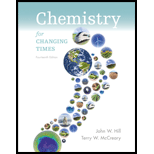
Chemistry For Changing Times (14th Edition)
14th Edition
ISBN: 9780321972026
Author: John W. Hill, Terry W. McCreary
Publisher: PEARSON
expand_more
expand_more
format_list_bulleted
Concept explainers
Question
Chapter 21, Problem 1RQ
Interpretation Introduction
Interpretation:
Advantages and disadvantages of soap should be identified.
Concept introduction:
Soap is a substance used with water for cleansing and washing. Soaps are made from oils and fats, or their fatty acids, by treating them with strong alkali chemically. Soap is a sodium or potassium salt of a long a chain of fatty acid.
Expert Solution & Answer
Answer to Problem 1RQ
Solution:
The main disadvantage of soap is that it does not work well in hard water and the main advantage of soap is that it is derived from renewable sources.
Explanation of Solution
Advantages of soap:
- It is an excellent cleanser in soft water.
- It is relatively non-toxic.
- It is derived from renewable sources (animal fats and vegetable oils).
- It is biodegradable.
Disadvantages of soap:
- It does not work well in hard water as hard water contains calcium, magnesium and iron ions. The anions of soap react with the metal ions and form insoluble, greasy curds.
- In acidic solutions, soaps are converted to free fatty acids, which have no cleansing action and are also insoluble in water and separate as a greasy scum.
Conclusion
The main disadvantage of soap is that it does not work well in hard water and the main advantage of soap is that it is derived from renewable sources.
Want to see more full solutions like this?
Subscribe now to access step-by-step solutions to millions of textbook problems written by subject matter experts!
Chapter 21 Solutions
Chemistry For Changing Times (14th Edition)
Ch. 21 - Prob. 1RQCh. 21 - Prob. 2RQCh. 21 - Prob. 3RQCh. 21 - Prob. 4RQCh. 21 - Prob. 5RQCh. 21 - Prob. 6RQCh. 21 - Prob. 7RQCh. 21 - Prob. 8RQCh. 21 - Prob. 9PCh. 21 - Prob. 10P
Ch. 21 - Prob. 11PCh. 21 - Prob. 12PCh. 21 - Prob. 13PCh. 21 - Prob. 14PCh. 21 - Prob. 15PCh. 21 - Prob. 16PCh. 21 - Prob. 17PCh. 21 - Prob. 18PCh. 21 - Prob. 19PCh. 21 - Prob. 20PCh. 21 - Prob. 21PCh. 21 - Prob. 22PCh. 21 - Prob. 23PCh. 21 - Prob. 24PCh. 21 - Prob. 25PCh. 21 - Prob. 26PCh. 21 - Prob. 27PCh. 21 - Prob. 28PCh. 21 - Prob. 29PCh. 21 - Prob. 30PCh. 21 - Prob. 31PCh. 21 - Prob. 32PCh. 21 - Prob. 33PCh. 21 - Prob. 34PCh. 21 - Prob. 35PCh. 21 - Prob. 36PCh. 21 - Prob. 37PCh. 21 - Prob. 38PCh. 21 - Prob. 39PCh. 21 - Prob. 40PCh. 21 - Prob. 41PCh. 21 - Prob. 42PCh. 21 - Prob. 43PCh. 21 - Prob. 44PCh. 21 - Prob. 45PCh. 21 - Prob. 46PCh. 21 - Prob. 47PCh. 21 - Prob. 48PCh. 21 - Prob. 49PCh. 21 - Prob. 50PCh. 21 - Prob. 51PCh. 21 - Prob. 52PCh. 21 - Prob. 53PCh. 21 - Prob. 54PCh. 21 - Prob. 55PCh. 21 - Prob. 56PCh. 21 - Prob. 57PCh. 21 - Prob. 58PCh. 21 - Prob. 59PCh. 21 - Prob. 60PCh. 21 - Prob. 61PCh. 21 - Prob. 62PCh. 21 - Prob. 63PCh. 21 - Prob. 64PCh. 21 - Prob. 65PCh. 21 - Prob. 66PCh. 21 - Prob. 67PCh. 21 - Prob. 68PCh. 21 - Prob. 69APCh. 21 - Prob. 70APCh. 21 - Prob. 71APCh. 21 - Prob. 72APCh. 21 - Prob. 73APCh. 21 - Prob. 74APCh. 21 - Prob. 75APCh. 21 - Prob. 76APCh. 21 - Prob. 77APCh. 21 - Prob. 78APCh. 21 - Prob. 79APCh. 21 - Prob. 80APCh. 21 - Prob. 81APCh. 21 - Prob. 82APCh. 21 - Prob. 83APCh. 21 - Prob. 84APCh. 21 - Prob. 85APCh. 21 - Prob. 86APCh. 21 - Prob. 21.1CTECh. 21 - Prob. 21.2CTECh. 21 - Prob. 21.3CTECh. 21 - Prob. 21.4CTECh. 21 - Prob. 21.5CTECh. 21 - Prob. 21.6CTECh. 21 - Prob. 21.7CTECh. 21 - Prob. 21.8CTECh. 21 - Prob. 21.9CTECh. 21 - Prob. 1CGPCh. 21 - Prob. 2CGPCh. 21 - Prob. 3CGPCh. 21 - Prob. 4CGPCh. 21 - Prob. 5CGPCh. 21 - Prob. 6CGPCh. 21 - Prob. 7CGPCh. 21 - Prob. 8CGPCh. 21 - Prob. 1CHQCh. 21 - Prob. 2CHQCh. 21 - Prob. 3CHQ
Knowledge Booster
Learn more about
Need a deep-dive on the concept behind this application? Look no further. Learn more about this topic, chemistry and related others by exploring similar questions and additional content below.Recommended textbooks for you
 ChemistryChemistryISBN:9781305957404Author:Steven S. Zumdahl, Susan A. Zumdahl, Donald J. DeCostePublisher:Cengage Learning
ChemistryChemistryISBN:9781305957404Author:Steven S. Zumdahl, Susan A. Zumdahl, Donald J. DeCostePublisher:Cengage Learning ChemistryChemistryISBN:9781259911156Author:Raymond Chang Dr., Jason Overby ProfessorPublisher:McGraw-Hill Education
ChemistryChemistryISBN:9781259911156Author:Raymond Chang Dr., Jason Overby ProfessorPublisher:McGraw-Hill Education Principles of Instrumental AnalysisChemistryISBN:9781305577213Author:Douglas A. Skoog, F. James Holler, Stanley R. CrouchPublisher:Cengage Learning
Principles of Instrumental AnalysisChemistryISBN:9781305577213Author:Douglas A. Skoog, F. James Holler, Stanley R. CrouchPublisher:Cengage Learning Organic ChemistryChemistryISBN:9780078021558Author:Janice Gorzynski Smith Dr.Publisher:McGraw-Hill Education
Organic ChemistryChemistryISBN:9780078021558Author:Janice Gorzynski Smith Dr.Publisher:McGraw-Hill Education Chemistry: Principles and ReactionsChemistryISBN:9781305079373Author:William L. Masterton, Cecile N. HurleyPublisher:Cengage Learning
Chemistry: Principles and ReactionsChemistryISBN:9781305079373Author:William L. Masterton, Cecile N. HurleyPublisher:Cengage Learning Elementary Principles of Chemical Processes, Bind...ChemistryISBN:9781118431221Author:Richard M. Felder, Ronald W. Rousseau, Lisa G. BullardPublisher:WILEY
Elementary Principles of Chemical Processes, Bind...ChemistryISBN:9781118431221Author:Richard M. Felder, Ronald W. Rousseau, Lisa G. BullardPublisher:WILEY

Chemistry
Chemistry
ISBN:9781305957404
Author:Steven S. Zumdahl, Susan A. Zumdahl, Donald J. DeCoste
Publisher:Cengage Learning

Chemistry
Chemistry
ISBN:9781259911156
Author:Raymond Chang Dr., Jason Overby Professor
Publisher:McGraw-Hill Education

Principles of Instrumental Analysis
Chemistry
ISBN:9781305577213
Author:Douglas A. Skoog, F. James Holler, Stanley R. Crouch
Publisher:Cengage Learning

Organic Chemistry
Chemistry
ISBN:9780078021558
Author:Janice Gorzynski Smith Dr.
Publisher:McGraw-Hill Education

Chemistry: Principles and Reactions
Chemistry
ISBN:9781305079373
Author:William L. Masterton, Cecile N. Hurley
Publisher:Cengage Learning

Elementary Principles of Chemical Processes, Bind...
Chemistry
ISBN:9781118431221
Author:Richard M. Felder, Ronald W. Rousseau, Lisa G. Bullard
Publisher:WILEY